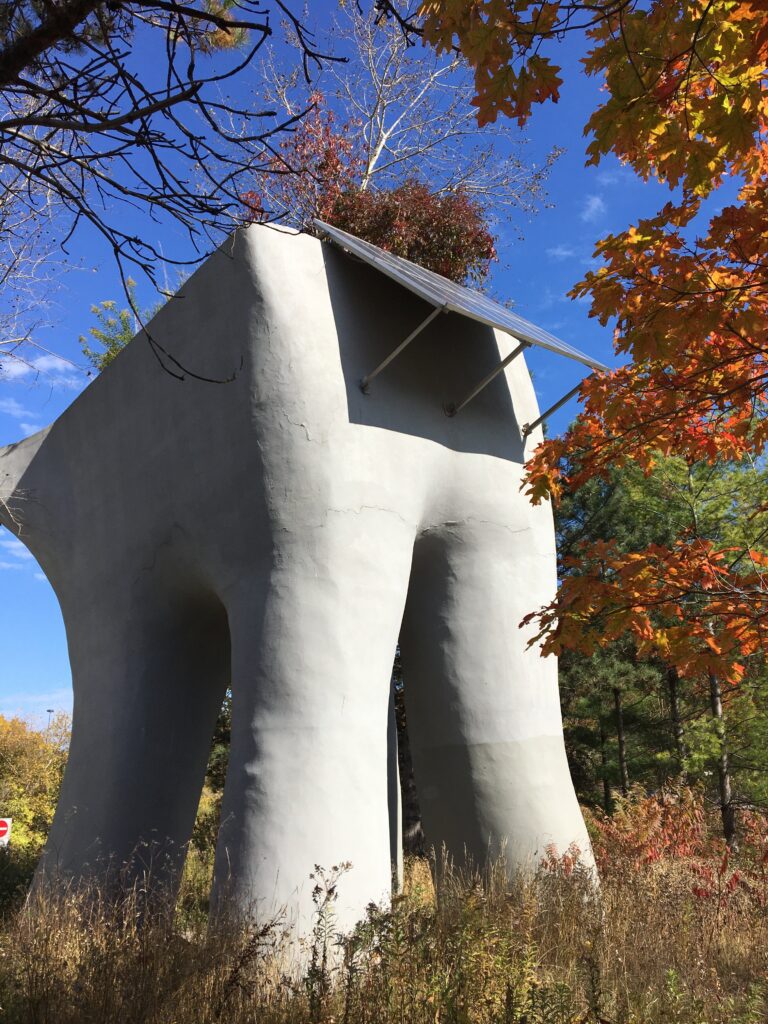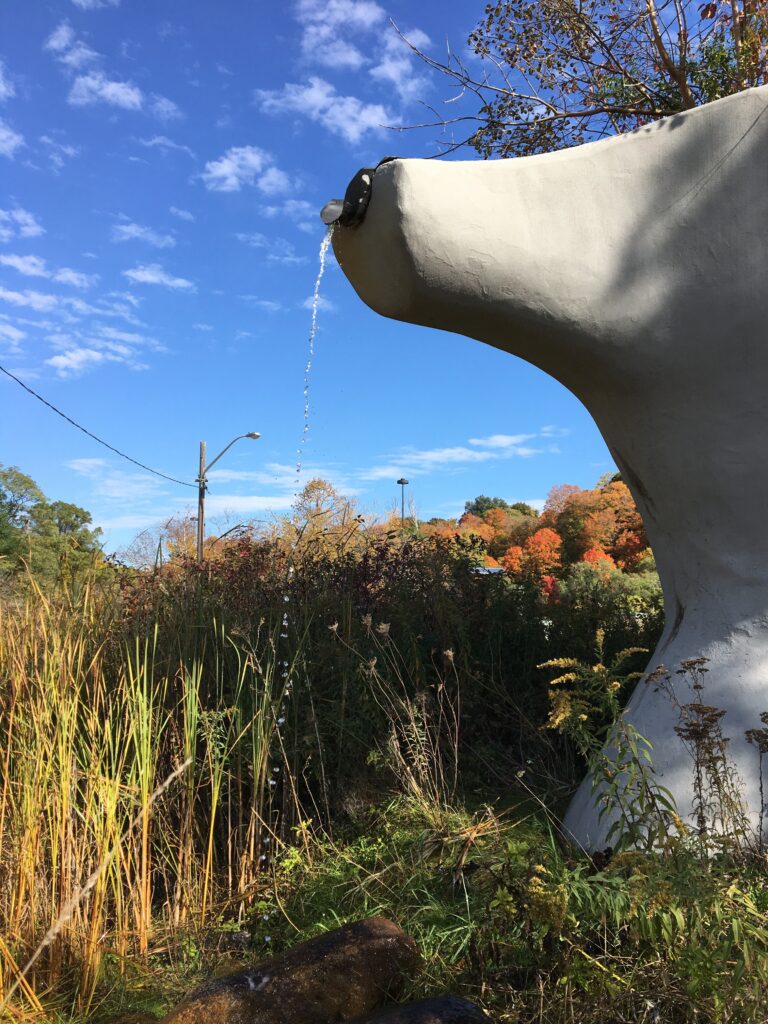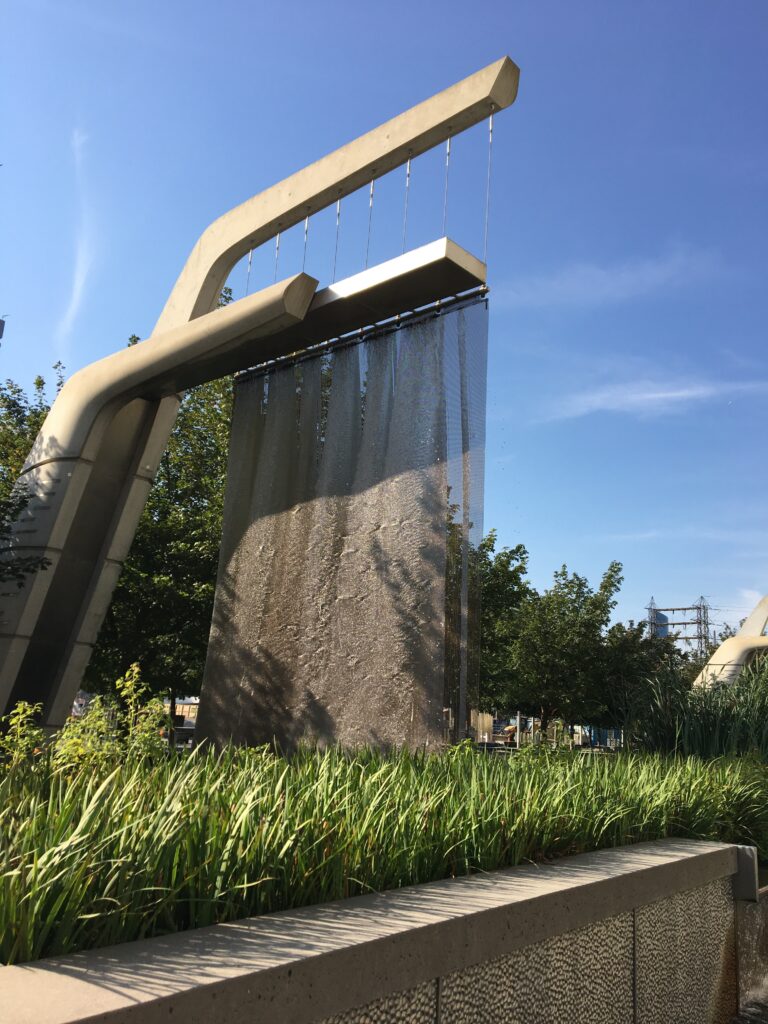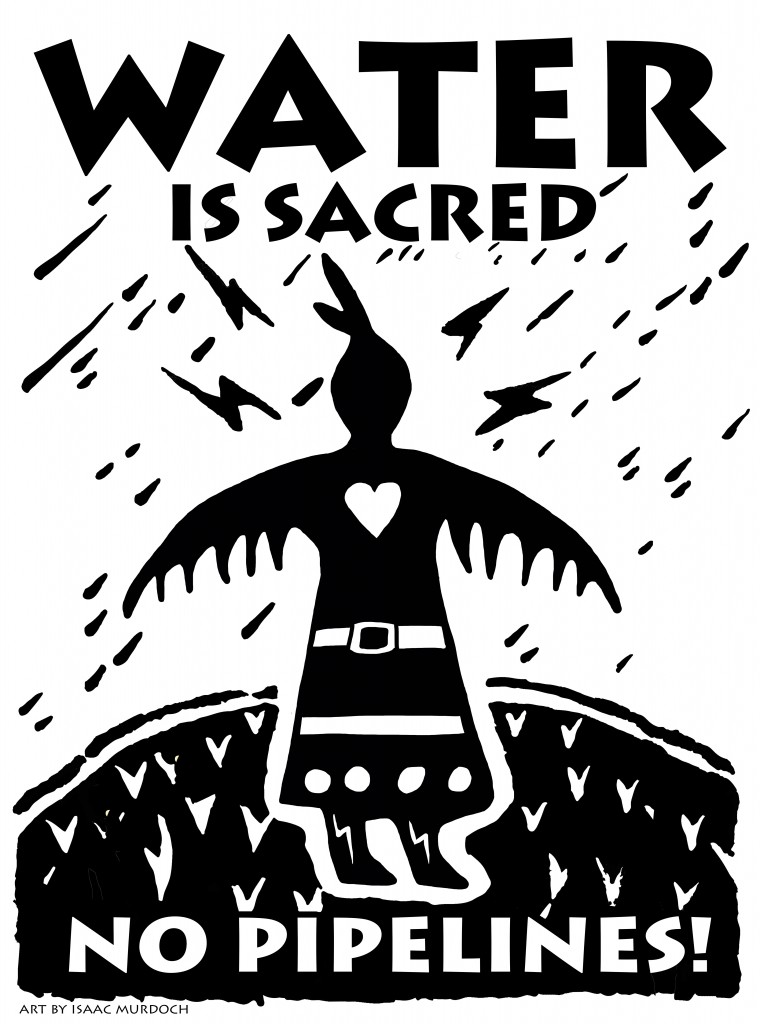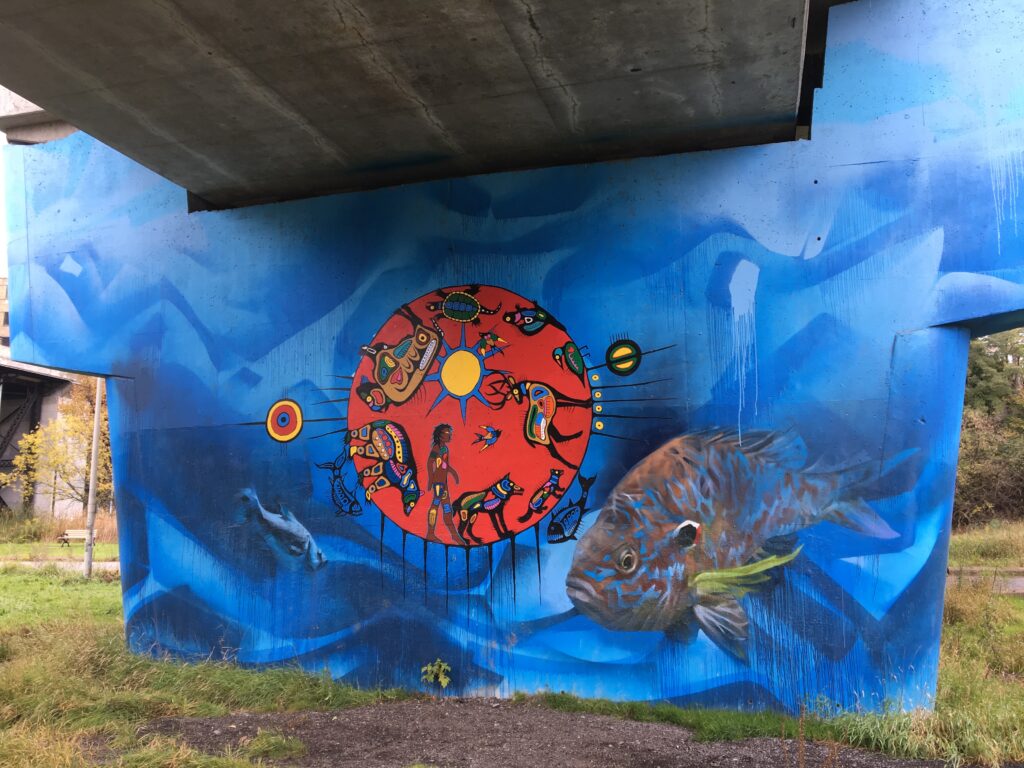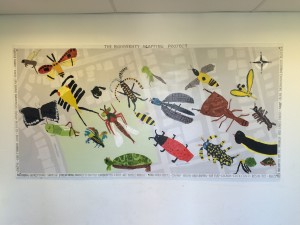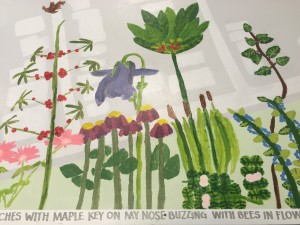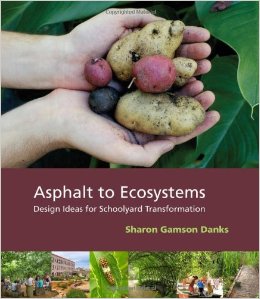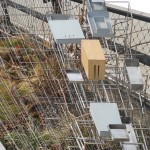Iãve been learning more about regenerative sustainability recently from my colleague John Robinson, who has been a vocal advocate for it at the University of Toronto in recent years (and at UBC for many years before that).ô This is built on the premise that itãs not enough to create communities that are ãnet zeroã in terms of their greenhouse gas emissions, but in fact are ãnet positiveã by actively contributing to a more sustainable world.ô John introduced me to this through the Centre for Interactive Research on Sustainability at UBC, (a building he helped design; it sends rain water used to flush toilets in the building back into the sewer cleaner than it arrived).ô So Iãve been looking for examples of ãregenerative art-makingã, and realized that we have two excellent examples of this in permanent installations of this in Toronto.ô Noel Hardingãs ‘Elevated Wetlandsã (1999), recognized by many Torontonians for its prominent position along the DVP, was an early example of this. Using solar pumps, native plants and a recycled plastic substrate, Noel integrated science and art to model how an art installation can contribute to the cleansing of the Don River (known as one of Canadaãs most polluted rivers.) Jill Anholt picked up on this two decades later in her design for Sherbourne Common, a small park on Torontoãs waterfront.ô With a similar purpose in mind, Anholtãs design uses UV light, native plantings and a mesh screening system to cleanse storm-water run off before it goes into lake Ontario. Both artworks create inspiring, purposeful spaces that model regenerative sustainability in creative ways – we need more like these around the word!
Art as Regenerative Sustainability
Learning from First Nations’ Artists
Are artworks created by First Nations artists a form of environmental art-making?ô Many can be considered as such, based on the imagery and meaning of their works; some draw attention to the natural world, are made with biodegradable materials, celebrate the interconnectedness of all forms of life and/or take an activist stance on environmental issues.ô I was honoured to learn from two artists who are well-known environmental activists here in Ontario – Christi Belcourt (Mûˋtis) and Isaac Murdoch (Ojibwe) (they were keynote speakers this year as part of our national conference in Environmental & Sustainability Education). They are the founders of the Onaman Collective, which focuses on a resurgence of First Nations language and Land-based practices. They have co-designed a series of graphic black and white images that draw on First Nations symbolism to support environmental activism, which they generously share for free with other activists.ô These small-scale, abstracted works sit in contrast to the huge colourful murals created by artist and traditional wisdom keeper Phil Cote (Potawatomi) around the city of Toronto; he leads the Tecumseh Collective. One series of his works is found on the edge of the Humber River, which feature the integral relationships between native riparian wildlife and First Nation peoples. ô All three of these artists take time to work in K-12 schools with children around the GTA and the province, generously sharing their knowledge of and commitment to the Land with the next generation, hopefully leading both Indigenous and settler children to live more lightly on the Earth.
Growing a Garden-Based Approach to Art Education
The gardens around schools, whether found in the schoolyard or a nearby park, can be a great way to inspire and integrate learning across the curriculum.ô ô I was happy to have this recognized recently by the international Art Education journal, which published ãGrowing a Garden-Based Approach to Art Educationã in their July 2018 issue, and put on of the photos of the article on the cover!ô Co-authored with OISE graduate student (now alumni) Jennifer Sharpe, we aimed to explore the joys of taking art education into the school garden as a way to inform, inspire, and celebrate studentsã creativity. Drawing on the tenets of place-based education and nature-based learning, we presented a case study of a vibrant school garden in Toronto that has been the site of childrenãs artistic exploration for over a decade. We know that when art education is conducted in schoolyards and school gardens, using these spaces as sites of discovery, creativity, meaning-making, and experimentation, children are able to deepen their understanding of the natural and built world, and develop strong connections to the environments in which they live.ô If youãd like to read more, access the article at:ô https://www.tandfonline.com/doi/full/10.1080/00043125.2018.1465318
Inspired by Burning Ice
What a busy fall! ô Not as much time to blog as I would have liked following my trip to the Arctic this summer, but the trip has given me lots to think about in relation to climate change and the role that artists can play in addressing it. ô This was furthered by listening to a talk by Nigel Roulet in October – he is an eminent Canadian environmental scientist from McGill university who shared his belief in the power of the arts to communicate environmental ideas in moving ways, something that science hasn’t typically done well in the past. ô
Perhaps the best way to magnify the communications about climate change is to take a multi-faceted approach. ô The Cape Farewell project is one of the best examples of this so far; by bringing environmental scientists together with artists, musicians, writers and filmmakers, aiming to create innovative ways to reach a wider audience about the impacts of climate change. ô Their interdisciplinary book, called Burning Ice: Art and Climate Change, serves as travelogue, atlas, art catalogue, and scientific documentation all in one. ô Other groups have experimented with this model, including Greenpeace andô 350.org, bringing scientific knowledge together with the affective and intuitive ways of knowing from the arts to create memorable and moving messaging about climate change. ô The Canada C3 expedition I was on last summer is aiming to do the same. ô They have a number of legacy projects on the go to share our collective experiences about climate change, reconciliation, and inclusion in the North; Iãll share these as they come available.

Results of the Biodiversity Mapping Project
What a busy end to the spring!ô ô While one group of my students was helping with the installation of our Bee the Change project, another was working alongside me and the K-8 students at Keele PS on the Biodiversity Mapping Project. The latter was a 10 day eco-art project that resulted in eight large murals for the school, acting as aesthetic responses to the children’s learning in science, art and geography over the course of four months.ô ô They studied the concept of biodiversity – species, ecosystems, and genetic – through research, reading, and outdoor exploration, and shared what they learned through drawing, painting, and creative map-making. Each of the murals has a similar background – a map of part of the catchment area of the school – that if put all together, show the neighbourhood around Keele.ô ô On the top layer is one form of life that contributes to local biodiversity, from insects (gr. 1s) through to genetic diversity (gr. 8s.) ô Around the edge is text written by the students to act as a framing device – in some cases poetry, in other cases the names of the species depicted. ô We worked to reduce the eco-footprint of this painting project by minimizing and collecting the painting wastewater, as well as by reusing old mural panels. The results are meaningful AND beautiful, helping the students, teachers and community members better understand the importance of local biodiversity.ô Iãm very appreciative of the opportunity to work with the wonderful teachers and students at Keele; the help from my teacher candidates was the topping on the cake!
Collaborative Art-making in ‘Common Threads’
I attended a great talk on Eco-art recently by artist Sharon Kallis from Vancouver. She has authored a new book called ‘Common Threads’, which explores the use of collaborative art making as a way to raise awareness of the natural world and the environmental issues it faces. Invasive plant species are of particular concern, as she experiments with ways to re-purpose these plants as art material to deal with sustainability challenges. Sharon has created clothing out of plants, for example, weaving leaves and stems into functional material. I really enjoyed learning more about the community gardens she has been involved in in Vancouver, always with an eye on how the garden might be used as exhibition site or as a source for biodegradable art materials.ô ô Recently she has been growing flax to make into linen fibre, (demonstrating that she has far more patience than I do!) I really appreciate her use of art-making techniques with a rich history, and ones that have often been positioned as ‘women’s work’, helping to reclaim these into the lexicon of contemporary art practice. At the core of this work is always a focus on using art to build community, an important part of living more sustainably on the earth. More info about Sharon’s work can be found here:ô http://sharonkallis.com/ 
Growing Art in Schoolyards
I was spending a lot of time in gardens over the summer, and some in school gardens.ô Iãm always on the lookout for ideas about how art can be incorporated into school yards as I think itãs a great tool to raise environmental awareness and even bring about environmental change.ô There is lots of experimentation going on in Toronto in this area, and it is exciting to find a new artwork in a schoolyard to support student learning.ô If youãre looking for ideas in this regard, Pinterest has lots of ideas in visual forms.ô You can also refer to a great book called Asphalt to Ecosystems:ô Design Ideas for Schoolyard Transformation by Sharon Gamson Danks (published by newvillagepress).ô Sharon is a Californian consultant on schoolyard greening, and has travelled around the world photographing amazing schoolyard designs.ô While any aspect of a greening project could be considered a form of aesthetic design, from the pathways to the plantings to the play equipment, she has included a few chapters dedicated to the diverse and stimulating roles that art can play to enhance childrenãs ecological literacy. ô ô Check out the gallery on my website for more ideas on this topic.
Where Do Eco-Art Ideas Come From?
At the start of another new year at OISE, we are in planning mode to create a few new eco-artworks with our students.ô These projects have been well-received, and are successfully drawing attention to creating a culture of sustainability in our institution.ô We’ve been very lucky to have support from our CAO in this as she provides financial support to make them happen…it would be hard to make projects happen with no budget.ô But once the funding is in place, I’m often asked ‘where do you start’?ô How do you find the spark of inspiration that begins the creative process?ô I draw on a variety of sources for this – sometimes it comes from campaigns or organizations that are addressing an important environmental issue that we want to support.ô In other instances it has been a way to raise awareness about an issue we know is of concern to our organization specifically (our FLAP project is an example).ô Often it’s a technique or image from an existing artwork that inspires, triggering the reaction “I want to try that!” (This is a great way to push yourself to move beyond the art-making strategies you feel most comfortable with.)ô ô And at times it has been a request from someone in the organization to help to address a specific concern (aesthetic or environmental.)ô We’ve already got a project underway as an example of the latter; we were approached to provide new artwork for one of the busy meeting rooms in the building.ô This provided an opportunity to improve a space in the building aesthetically, and another way to get across the message about sustainability. This has translated into a series of large-scale photos of our Learning Garden, and will allow the garden to have a permanent, year-round presence inside the building.ô I’ll post photos of this installation here in the next few months as it is completed.
World Premiere of My Eco-Art Video!
Such a busy winter, but so many fun projects happening along the way!ô I started my own You Tube channel called ãEcoArt Edã, and posted my first video about making ecoart with elementary children.ô You can find it here:
http://www.youtube.com/watch?v=3PhYowsFGNM
The project came about thanks to my sister Karen Somers, who is a filmmaker and photographer in LA (check out her website at http://www.karensomers.com/ )ô We shot the footage last summer when she was in town ã a fitting end as I was wrapping up a long standing commitment to the school featured in the video.ô We didnãt have time to script, so we shot mainly in one or two takes when we had time.ô She left me the raw footage, and I worked on editing it last fall.ô It was my first experience using iMovie, so the learning curve was steep, but Iãm pleased with the result.ô (Thanks also to my son Alex for his help with the editing ã it really was a family affair!)ô It certainly has reminded me to document all that is done when working on ecoart projects ã just sharing the results with others can inspire them to try eco-artmaking themselves!
The High Line is a Highlight!
Iãm still thinking about my trip to New York in March ã itãs such a wonderful city to inspire thought and action.ô One of the fondest memories I have taken away from it was my trip to the High Line, a new public park that sits on an old raised railway line on the west side of Manhattan.ô It runs from Gansevoort Street in the Meatpacking District to West 34th Street, between 10th & 11th Avenues.ô On it you find the old train rails interspersed with plantings, eco-artworks, benches, and amazing views of the neighbourhoods that surround it.ô Itãs an entirely unique way to experience NYC as you are raised above but still part of the fabric of the city.ô Below are photos of just two of the artworks that have been beautifully immersed into the parkãs design.ô The stained glass piece is by Spencer Finch, who was inspired by the colours of the nearby Hudson River; the amazing birdhouses are by artist Sarah Sze.ô If youãre in Manhattan, a visit to the High Line is a must ã just as inspiring as visiting the galleries!ô For more info, visit:ô ô
